The case of a tourist couple who were charged €125 for five prawns caused widespread press coverage last month, but if anything, it highlights the importance of knowing a little about ordering in Spain.
In the case in question, the tourists had asked for king prawns. When these weren’t available, they were offered carabineros and agreed. Their seafood arrived – five large scarlet prawns – and they ate them. However, they were horrified to receive a bill for €125.
This was no rip-off. Fresh carabineros are only fished in the La Santa area of Lanzarote. They are highly prized and €25 per prawn is not an unreasonable price for a frontline restaurant to ask for them. It was obvious that there had been a lack of communication between customer and waiter.
The Spanish probably prize good seafood more than any other country apart from Japan and will pay high prices for high quality products. Fresh elvers (baby eels), for example, can cost over €1,000 a kilo on the mainland, while the range of seafood, which included camarones, langostinos, gambas, cigalas and carabineros, is wide and confusing.
To avoid confusion and nasty surprises, it’s best to be aware of a few facts and customs.
When ordering fish and seafood, remember that almost anything with a fixed price on the menu is likely to be frozen. Supplies of frozen food can be guaranteed, allowing restaurants to plan ahead.
Lots of restaurants will offer “fresh fish of the day” (pescado del día), but the price will either be listed on the specials board or available from the waiter. The type of fish and its price will rely entirely on what was caught that day.
The only fresh prawns you’ll find on Lanzarote outside of Christmastime are the expensive ones from La Santa. Smaller ones may be a little cheaper than the large carabineros, but they’ll still be extremely expensive compared to the frozen prawns that cost €12 a kilo at the supermarket. Fresh lobsters are also available but will have been kept in a tank.
The important lesson that the prawn row teaches us is that communication is the most important thing in a restaurant, and that if an item is unpriced, make sure you ask before ordering.
Here’s a very rough guide to seafood in Spanish restaurants:
Camarón – Shrimp. The smallest variety, usually fished in the Mediterranean or Atlantic. 40-70 per kilo
Gamba – Prawn. The term covers various species of prawns from all over the world, with a range of sizes from 10 to 60 per kilo.
Langostino – Like prawns, but with coarser flesh. 10 to 60 per kilo
Cigala – Dublin Bay prawn or langoustine. 12- 18 per kilo
Carabinero – Cardinal prawn. Deep scarlet when cooked. 6-8 per kilo
Langosta/Bogovante – Lobster
How to eat a prawn
In Spain, shelling and eating prawns is often done at the table by diners. It’s a process where you’re allowed to get messy
1. Pull the prawn’s head away. Spaniards often suck the sweet juices from the head.
2. Pull the prawn’s tail off sharply.
3. Use fingernails (or a knife blade) to peel the hard shell from the prawn. Recently, a fork trick, involving pushing the tine of a fork into the upper part of the prawn and pushing the shell over it, has gone viral.
4. Remove dark vein (intestinal tract).












Leave a Reply
Want to join the discussion?Feel free to contribute!